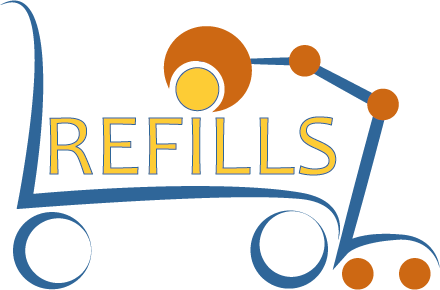Robotics for logistics in warehouses and environments shared with humans
Full day Workshop, Friday October 5, 2018
The pdf files of the presentations can be downloaded from here!
The workshop is organized by the topic group on Robotics for Logistics and Transport of euRobotics AISBL and by following European Union’s H2020 projects:
- ILIAD – iliad-project.eu
- REFILLS – refills-project.eu
- RoPod – europa.eu/project/rcn/206247_en.html
- SafeLog – safelog-project.eu
with the support of other running H2020 projects addressing research and technological issues that are closely related to logistics: Co4Robots, SciRoc.
 |
 |
 |
 |
 |
Organizers
Objectives
Topics of interest
Submission instructions
Important dates
Program
ORGANIZERS
OBJECTIVES
The world of logistics and distribution is a strongly growing sector for suppliers of robot technologies and a field full of interesting challenges for robotics research. Robots today are able to perceive, recognize, pick and manipulate a wide variety of objects. They are able to navigate and move things in less and less structured environments. They can collaborate with human operators in shared workspaces, interacting safely with employees and customers. These advances in robotic technologies, together with their relatively low costs, make robotic solutions appealing not only for all the components of the logistics supply chain, including warehouses, distribution centers, sorting centers, last-mile delivery, but also for intra-logistic operations in retail stores, care facilities, and hospitals.
The European Union’s H2020 research and innovation program funded a number of projects related to robotics for logistics in warehouses and environments shared with humans. Four of them (ILIAD, REFILLS, RpPod, SafeLog), involving research institutions, logistic companies, robot manufacturers, end-users from different European countries, are committed to the workshop organization.
The project ILIAD: Intra-Logistics with Integrated Automatic Deployment for safe and scalable fleets in shared spaces (iliad-project.eu) is aimed at developing robotic solutions for intra-logistic services that can easily integrate with current warehouse facilities. The focus is on self-deploying fleets of heterogeneous robots, on-line self-optimizing fleet management, mobile manipulation, efficient and safe operation in an environment shared with humans.
The project REFILLS: Robotics Enabling Fully‐Integrated Logistics Lines for Supermarkets (www.refills-project.eu) aims at improving logistics in a supermarket thanks to mobile robotic systems in close and smart collaboration with humans, addressing the main in-store logistics processes for retail shops: shelf monitoring, store delivery and pre-sorting, smart shelf refilling.
The project RoPod: Ultra-flat, ultra-flexible, cost-effective robotic pods for handling legacy in logistics (cordis.europa.eu/project/rcn/206247_en.html) is aimed at developing and implementing a disruptive concept for AGVs that lowers the existing barriers in logistics by offering automated and semi-automated indoor transportation of goods, without imposing disruptive changes in existing logistic solutions. Equal emphasis is put on cost-effective as well as on human-friendly automation of logistic tasks, making the solution suitable for environments like hospitals and care facilities.
The project SafeLog: Safe human-robot interaction in logistic applications for highly flexible warehouses (safelog-project.eu) proposes the conception and implementation of a Large-scale flexible warehouse system which enables a safe and efficient collaboration of human and robots in the same area and at the same time. There are three main components being developed to achieve this vision. The first is the development of a safety-certifiable safety vest that prevents robots from coming into the proximity of the human worker, thus preventing accidents. The second is a fast heterogeneous path planner that can quickly plan and re-plan routes with constraints for different types of agents (AGVs, humans, autonomous forklifts etc.). Finally, an AR-based worker support system is developed for picking, maintenance, and navigation assistance.
Starting from the research and technological issues of the above projects, that will be reported by the protagonists, this workshop intends to share knowledge about technological opportunities and challenges regarding robotics for logistics. The aim is to bring together and confront the experience of researchers, end users, logistics and robotics companies working on novel approaches, through a mixture of talks from invited speakers, an interactive poster session and a round-table discussion.
TOPICS OF INTEREST
The topics of interest, related to robotics for logistics, will include but are not limited to the following:
- Intelligent transportation systems
- Robotic systems in logistics
- Inventory management
- Planning, scheduling, and coordination of heterogeneous human-robot fleets
- Path planning for multiple mobile robots or agents
- Software, middleware and programming environments
- Perception for grasping and manipulation
- Reactive and sensor-based planning
- Sensor-based control
- Gripper and other end-effectors
- Computer vision for transportation
- Semantic scene understanding
- Object detection, segmentation, and categorization
- Human factors and human-in-the-loop
- Human detection and tracking and intention recognition
- Robot safety
- Safe human-robot interaction/collaboration in robot warehouses
- Human-centered robotics in warehouses
- Human-centered automation
- Model learning for control
- Virtual reality and augmented reality
- Robot design for logistics
- Ethics of human-robot collaboration in logistic warehouses
SUBMISSION INSTRUCTIONS
We invite extended abstracts of 2 pages (pdf, in the standard format for IEEE IROS conference). Submissions should describe one or more of the above topics of interest. All the submissions will be evaluated by the workshop organizers based on relevance to the workshop topics, technical quality, and novelty. Authors of accepted abstracts are expected to attend the workshop with a spot-light talk (~5 mins) and to present their work as posters during the interactive session with posters prepared in advance. The accepted abstracts will be posted on the workshop website and will not appear in the official IEEE proceedings.
The extended abstracts in pdf format must be sent to: Questo indirizzo email è protetto dagli spambots. E' necessario abilitare JavaScript per vederlo.
IMPORTANT DATES
Submission deadline: September 15
Notification of acceptance: Ten days after submission
Final submission: September 26
Registration: see the IROS2018 web site at: https://www.iros2018.org
PROGRAM
October 5, 2018, Room PARIS 1.L2 |
| 09:00-09:10 | Welcome and introduction |
| 09:10-09:25 | ILIAD in a nutshell - Achim Lilienthal, Örebro University, Sweden |
| 09:25-09:40 | SAFELOG in a nutshell - Björn Hein, Karlsruhe Institute of Technology, Germany |
| 09:40-09:55 | REFILLS in a nutshell - Bruno Siciliano, Università di Napoli Federico II, Italy |
| 09:55-10:10 | ROPOD in a nutshell - Erwin Prassler, Hochschule Bonn-Rhein-Sieg, Germany |
| Part I - Human-robot collaboration in logistics |
| 10:10-10:30 | Using 50 years of injury research for making human-friendly robots - Saeed Abdolshah, Technical University of Munich, Germany |
|
10:30-11:00 | Interactive presentations highlights
|
| 11:00-11:50 | Coffee break & interactive session |
| 11:50-12:10 | Safe and efficient collaborative fleets of autonomous vehicles in shared warehouses - Achim Lilienthal, Örebro University, Sweden |
| 12:10-12:30 | Heterogeneous fleet planning with humans - Miroslav Kulich, Czech Technical University in Prague, Czech Republic |
| 12:30-12:50 | Safety vest and human localization for human-robot collaboration - Ivan Marković, University of Zagreb, Croatia and Gaël Ecorchard, CVUT, Czech Republic |
| 12:50-13:10 | Augmented reality and intention recognition in robotic warehouses - David Puljiz, Karlsruhe Institute of Technology, Germany |
| 13:10-13:30 | Benchmarking and benchmarking competitions for robotics in warehouses and environments shared with humans - Gerhard Kraetzschmar, Bonn-Rhein-Sieg University of Applied Sciences, Germany |
| 13:30-14:30 | Lunch break |
| Part II - Robotics applications in logistics |
| 14:30-14:50 | Learning of perceptual models of retail products using photo-realistic simulations of supermarkets - Ferenc Bálint-Benczédi, Universität Bremen, Germany |
| 14:50-15:10 | Leveraging simulation for instance segmentation in pick and place scenarios - Sebastian Höfer, Amazon Research, Germany |
| 15:10-15:30 | Modular and flexible: the features that logistics robots must have - Jordi Pages, PAL Robotics, Spain |
| 15:30-15:50 | Tactile finger tip sensors for shelf replenishment in retail stores: Design, control, and application - Ciro Natale, Università della Campania Luigi Vanvitelli, Italy |
|
15:50-16:20 | Interactive presentations highlights
|
| 16:20-17:10 | Coffee break & interactive session |
| 17:10-17:30 | Semantic store maps: Knowledge representation and reasoning for large-scale retail environments - Georg Bartels, Universität Bremen, Germany |
| 17:30-17:50 | Soft robotic solutions for warehouse applications: from bin picking to palletizing - Lucia Pallottino, Università di Pisa, Italy |
| 17:50-18:10 | Composable world models for robotics in logistics - Herman Bruyninckx, KU Leuven, Belgium |
| 18:10-18:30 | "Analysis mode!": Robot (remote) monitoring, inspection, and diagnosis as prerequisites for deploying robots to everyday environments - Alex Mitrevski, Hochschule Bonn-Rhein-Sieg, Germany |
| 18:30-18:50 | Simultaneous conflict-free task-assignment and path planning for multi-AGV systems - Cristian Secchi, Università di Modena e Reggio Emilia, Italy |
| 18:50-19:00 | Wrap-up session and conclusion |
Nike KD


